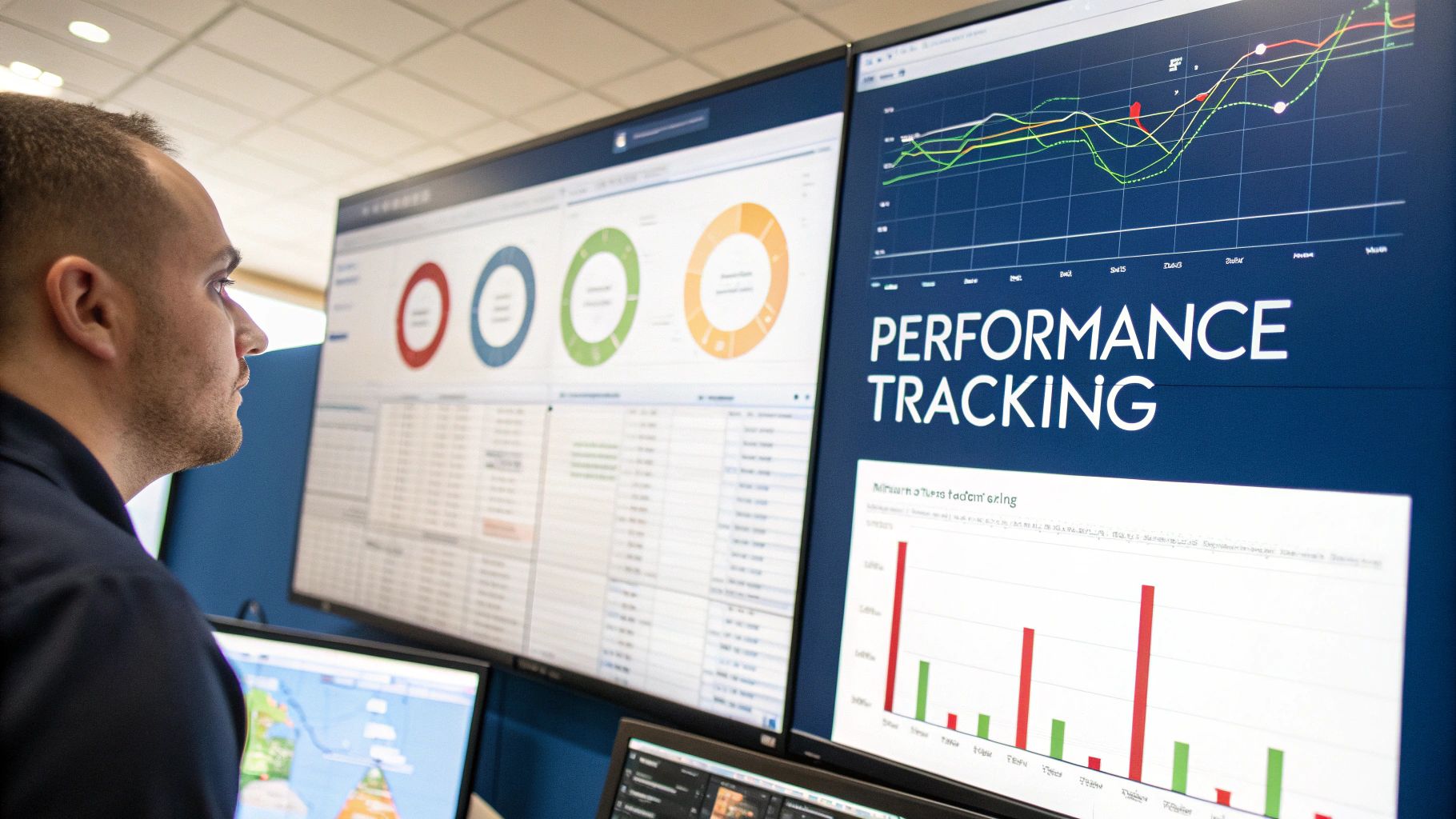How to Measure Staff Productivity: Essential Guide for Modern Leaders
Understanding The New Productivity Landscape

The way we track and measure employee output has fundamentally changed. Modern workplaces, with their mix of remote and office work, require a more sophisticated approach than simple time tracking. Simply counting hours no longer gives us an accurate picture of actual productivity and value creation.
Rethinking Traditional Metrics
Basic measurements like hours worked or tasks completed don't tell the full story anymore. An employee might spend eight hours at their desk but only generate four hours of meaningful work. These old approaches often miss important factors like work quality, team collaboration, and process efficiency. Even worse, focusing solely on time metrics can create unhealthy workplace habits where just being present matters more than delivering real results.
Embracing a Holistic Approach
Smart organizations are updating how they track performance. They now look at both hard numbers and subjective factors to get the complete picture. This means evaluating not just task completion, but also looking at methods, teamwork, and business impact. A key metric is labor productivity - comparing output to hours worked. Data from the U.S. Bureau of Labor Statistics shows that between 1979 and 2020, labor productivity grew by 61.8%. This focus on efficiency helps companies optimize their resources and find areas for improvement.
Measuring What Matters
Good productivity tracking starts with picking the right key performance indicators (KPIs) for your specific team and goals. These metrics should connect directly to your company's main objectives and reflect each role's unique contributions. Consider tracking things like customer satisfaction scores, project success rates, and quality benchmarks. The goal is to choose measurements that encourage good work habits and continuous growth, not just activity logging. When done right, this creates a workplace that values both high performance and employee wellbeing.
Building Your Performance Measurement Framework

Creating a strong performance measurement framework requires more than tracking basic metrics like hours worked. A well-designed approach helps organizations accurately assess staff productivity through careful metric selection, proper implementation, and regular evaluation. This gives managers the data they need to make informed decisions and continually improve team performance.
Choosing the Right Metrics
The most effective frameworks combine hard numbers with qualitative insights. Quantitative metrics provide concrete data points like sales figures or support tickets resolved. For instance, tracking ticket closure rates gives clear visibility into support team output. Qualitative measures examine how work gets done - looking at teamwork quality, communication effectiveness, and problem-solving abilities. Using both types creates a fuller picture of productivity.
Understanding employee contributions starts with selecting key performance indicators. One essential metric is task completion rate - the percentage of assigned work finished within specific timeframes. For example, completing 8 out of 10 tasks equals an 80% completion rate. This helps spot resource gaps and workload issues. Learn more about employee productivity metrics.
Implementing Metrics Effectively
Picking the right metrics is just the first step. Organizations must roll them out thoughtfully to boost employee motivation and maintain a positive culture. This means setting clear expectations, giving regular feedback, and using data to help staff grow. Keep data collection simple by using tools that automate tracking and reporting. You might be interested in: How to master productivity measurement tools.
Adapting Measurements Across Departments
Different teams need different success measures. Sales teams focus on revenue targets, while marketing teams track brand awareness and lead generation. Create a custom performance scorecard for each department that outlines their specific metrics and goals. This targeted approach ensures measurements match each team's unique contributions and responsibilities.
Setting Realistic Benchmarks and Leading Indicators
Building useful benchmarks requires analyzing industry standards, past performance data, and future objectives. Companies should set achievable targets that encourage steady improvement. Additionally, identify key leading indicators - early warning signs that predict future performance issues. This helps teams spot and fix potential problems before they impact results. Regular review and adjustment of the framework ensures it keeps providing valuable insights for optimizing productivity and meeting business goals.
Maximizing Resource Allocation Through Data

Using data to guide resource allocation decisions helps organizations improve their bottom line results. Rather than just tracking basic productivity metrics, companies need to analyze how these metrics connect to costs and outcomes. This deeper analysis enables smarter choices about staffing, training programs, and process improvements.
Calculating the ROI of Productivity Initiatives
When evaluating productivity initiatives, measuring return on investment (ROI) is essential. This means carefully comparing the costs of new tools and training against the resulting productivity gains. For instance, if new software saves 20% of time on tasks but comes with high costs, you'll need to determine if the time savings justify the investment. Consider both direct financial benefits and indirect gains like improved employee satisfaction and retention.
The total cost of workforce (TCOW) is another key metric that includes employee costs, overhead, and facilities expenses. Since workforce costs are typically the largest expense for businesses, tracking TCOW helps optimize labor strategies and spending. Learn more about workforce cost analysis at Visier's guide to measuring employee productivity. A clear view of TCOW empowers better resource planning.
Identifying and Addressing Resource Bottlenecks
Success requires spotting workflow bottlenecks before they create problems. This means analyzing where work slows down or gets stuck in your processes. Common bottleneck sources include understaffing, inefficient procedures, or missing tools. A design team waiting on approvals illustrates how streamlining one step can speed up entire projects. For more insights, see How to master advanced resource optimization techniques.
Real-World Examples of Optimized Resource Allocation
Many organizations have improved their resource allocation using productivity data. Some companies now offer flexible schedules based on when employees are most productive. Others use performance data to create targeted skills training, leading to measurable team improvements. These examples show how connecting productivity metrics to resource decisions delivers concrete benefits. By studying successful cases, businesses can adapt proven approaches to their specific needs.
Implementing Smart Tracking Systems That Scale

A successful performance measurement system needs the right tracking tools to work effectively. Choosing and implementing these tools requires careful consideration of employee needs and data privacy. Let's explore how to select and deploy systems that help both your organization and team members succeed.
Selecting the Right Tools for Your Needs
The first step is picking tracking tools that match your specific requirements. Different options range from basic time tracking to detailed activity monitoring. Key factors to consider include your team size, available budget, needed metrics, and how well tools work with your current software. Small teams may only need simple project management with time tracking, while larger companies often require more detailed activity analysis platforms.
Think about mixing manual and automated tracking. While automation makes data collection easier, you'll likely still need human input for things like team collaboration quality and communication effectiveness. This brings us to an essential point - maintaining employee trust.
Building Trust and Transparency With Employees
Team members often worry about privacy when it comes to activity tracking. Open communication helps address these concerns. Be clear about why you're tracking, what data you collect, and how you'll use it. For example, explain how the data helps spot workflow problems rather than monitor individual employees. Including team members in tool selection and setup helps build support and trust.
Ensuring Data Accuracy and Scalability
Your tracking system needs reliable data to be useful. Check your collection methods regularly to catch and fix any issues. Pick systems that can grow with your company - what works for 10 people might fall short with 100. Plan ahead for expansion by choosing flexible platforms or ones that can connect multiple tools smoothly.
Training and Support for Effective Use
Installing tracking tools is just the start. Teams need proper training on using the system and understanding the data. This includes learning about key metrics, finding and analyzing reports, and using insights to boost both individual and team results. Provide ongoing help and quick answers to questions to get the most value from your system. Remember: even great tools are worthless if people don't know how to use them properly. Good implementation leads to accurate data, employee support, and smart decisions that improve staff productivity.
Cultivating High Performance While Preserving Wellbeing
Creating a successful organization requires both strong employee satisfaction and excellent results. Leading companies know how to track staff performance while creating a healthy workplace. This means using data wisely, watching for signs of overwork, and promoting accountability in a supportive way.
Using Performance Data to Support Employee Growth
Performance tracking works best when focused on development, not just evaluation. Rather than highlighting weaknesses, use metrics to spot individual talents and improvement areas. For instance, an employee who excels at client relations but needs help with project planning can receive targeted coaching or mentoring. This method shows staff that tracking aims to help them grow and succeed.
Identifying and Addressing Burnout Risks Through Productivity Metrics
Watch performance data for early warning signs of burnout. Key indicators include unexpected drops in output, more frequent mistakes, or shifts in work patterns. Catching these signals early allows managers to adjust workloads, provide extra help, or suggest taking time off. Quick action prevents serious problems and keeps the workforce productive and healthy.
Creating Accountability Without Generating Stress
Good accountability practices don't need to cause anxiety. Focus on setting clear goals, keeping communication open, and giving regular feedback. Give staff the tools they need to succeed, set realistic targets, and celebrate achievements. When employees feel supported and valued, they naturally take ownership of their work without needing pressure that leads to stress.
You might be interested in: How to master game-changing workflow automation. Adding automation to handle routine tasks lets employees focus on more meaningful work that boosts both output and job satisfaction.
Real-World Examples of Balancing Performance and Wellbeing
Many successful organizations prove you can have both high performance and employee wellbeing. Some companies let staff work when they're most productive, respecting individual preferences. Others create recognition programs that connect performance data with rewards and career growth. These examples show how thoughtful productivity tracking creates positive workplaces benefiting both the company and its people. By emphasizing support, growth, and open dialogue, these organizations help employees do their best work while maintaining wellbeing.
Turning Productivity Insights Into Strategic Action
Understanding productivity data is important, but the real value comes from transforming these insights into meaningful actions. Just like having a map, the data itself isn't enough - you need to actively use it to guide your organization in the right direction.
Analyzing Productivity Trends and Identifying Opportunities
Think of productivity data as your organization's vital signs. Look for patterns over time - are certain days or projects consistently less productive? These trends may point to process bottlenecks or resource gaps that need addressing.
Pay attention to productivity peaks as well. What conditions led to these high-performing periods? Maybe it was a new collaboration tool or an effective team structure. Understanding these success factors helps you replicate them across the organization.
Developing Targeted Action Plans
With key areas for improvement identified, create focused action plans using the SMART framework: Specific, Measurable, Achievable, Relevant, and Time-bound. For example, if data shows workflow bottlenecks, set concrete goals around implementing new project management tools and training within set timeframes.
Consider practical solutions based on your data insights. If productivity dips after lunch, try:
- Scheduling energizing team activities
- Providing healthy snack options
- Adjusting meeting times to match energy levels
Optimizing Workflows and Training Programs
Use productivity metrics to refine both processes and training. When tasks consistently take longer than expected, examine whether you need to simplify workflows or provide additional staff training. Like a mechanic using diagnostic tools, these metrics help pinpoint exactly where improvements are needed.
Productivity data also enables personalized training approaches. By understanding individual performance patterns, you can create targeted learning plans that address specific skill gaps and boost overall team capabilities.
Practical Examples and Expert Insights
Real companies have seen concrete benefits from acting on productivity insights. Some found success with flexible schedules aligned to peak performance times. Others automated routine tasks to let staff focus on strategic work. These examples show how data-driven changes deliver measurable results.
Drive Measurable Results With Whisperit
Whisperit helps organizations put insights into action by streamlining administrative work and boosting efficiency. By automating documentation tasks, teams can focus more time on high-value activities. Experience how AI-powered dictation and editing tools can improve your workflows and help your team accomplish more.